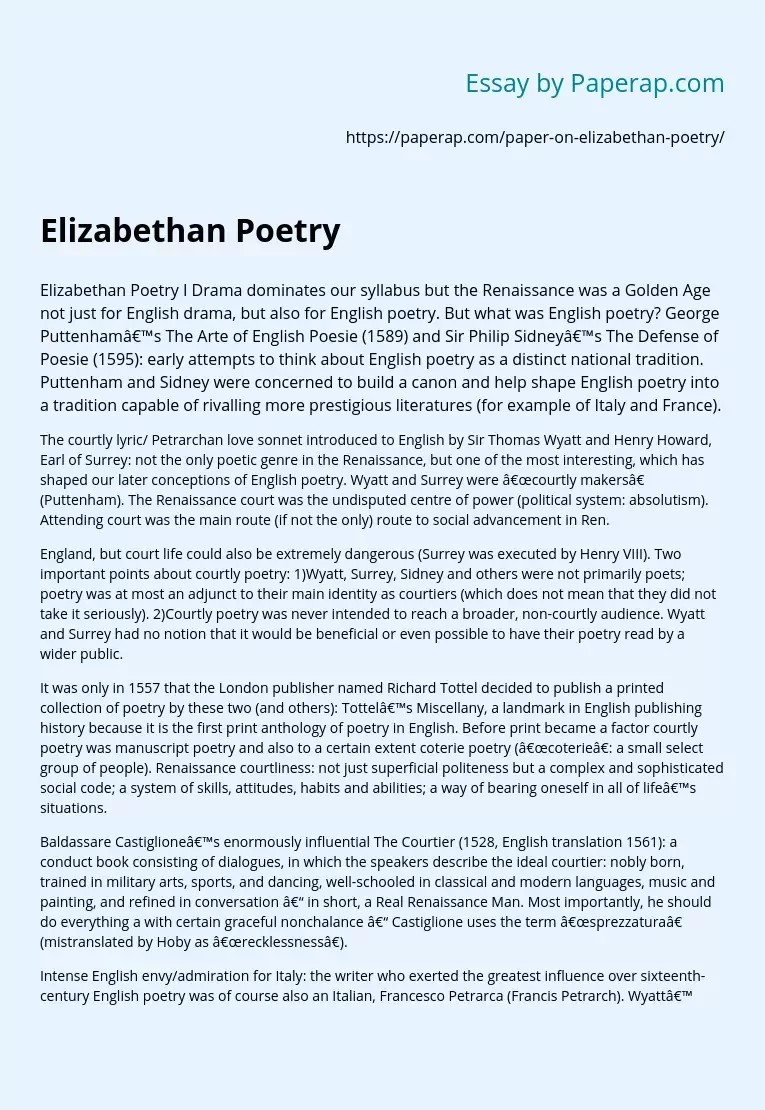Elizabethan Poetry I Drama dominates our syllabus but the Renaissance was a Golden Age not just for English drama, but also for English poetry. But what was English poetry? George Puttenham’s The Arte of English Poesie (1589) and Sir Philip Sidney’s The Defense of Poesie (1595): early attempts to think about English poetry as a distinct national tradition. Puttenham and Sidney were concerned to build a canon and help shape English poetry into a tradition capable of rivalling more prestigious literatures (for example of Italy and France).
The courtly lyric/ Petrarchan love sonnet introduced to English by Sir Thomas Wyatt and Henry Howard, Earl of Surrey: not the only poetic genre in the Renaissance, but one of the most interesting, which has shaped our later conceptions of English poetry. Wyatt and Surrey were “courtly makers” (Puttenham). The Renaissance court was the undisputed centre of power (political system: absolutism). Attending court was the main route (if not the only) route to social advancement in Ren.
England, but court life could also be extremely dangerous (Surrey was executed by Henry VIII). Two important points about courtly poetry: 1)Wyatt, Surrey, Sidney and others were not primarily poets; poetry was at most an adjunct to their main identity as courtiers (which does not mean that they did not take it seriously). 2)Courtly poetry was never intended to reach a broader, non-courtly audience. Wyatt and Surrey had no notion that it would be beneficial or even possible to have their poetry read by a wider public.
It was only in 1557 that the London publisher named Richard Tottel decided to publish a printed collection of poetry by these two (and others): Tottel’s Miscellany, a landmark in English publishing history because it is the first print anthology of poetry in English. Before print became a factor courtly poetry was manuscript poetry and also to a certain extent coterie poetry (“coterie”: a small select group of people). Renaissance courtliness: not just superficial politeness but a complex and sophisticated social code; a system of skills, attitudes, habits and abilities; a way of bearing oneself in all of life’s situations.
Baldassare Castiglione’s enormously influential The Courtier (1528, English translation 1561): a conduct book consisting of dialogues, in which the speakers describe the ideal courtier: nobly born, trained in military arts, sports, and dancing, well-schooled in classical and modern languages, music and painting, and refined in conversation – in short, a Real Renaissance Man. Most importantly, he should do everything a with certain graceful nonchalance – Castiglione uses the term “sprezzatura” (mistranslated by Hoby as “recklessness”).
Intense English envy/admiration for Italy: the writer who exerted the greatest influence over sixteenth-century English poetry was of course also an Italian, Francesco Petrarca (Francis Petrarch). Wyatt’s ”The long love that in my thought doth harbor” (527) and Surrey’s “Love, that doth reign and live within my thought” (571), written within a few years of each other, are both based on the same Petrarchan original. In terms of form, most Renaissance readers would probably have preferred Surrey’s smoother and more metrically harmonious verse (cf. ambic pentameter).
In terms of content, the early English Petrarchan sonnet rehearses a conventional situation, with relatively few variations. By means of various standard conceits (extended metaphors) the obsessive male speaker represents his tormented and hopeless desire. In contrast to the abject male the woman is calm and remote, virtuous and beautiful but cruelly indifferent. Why were courtly poets drawn to the Petrarchan love sonnet in the first instance? How do we understand the pain and frustration expressed in this poetry?
How can we make sense of this form and its popularity? Three points/suggestions:
- Renaissance writers and critics generally did not value poetry in terms of its genuineness or sincerity. The idea that poetry should be genuine or sincere is a much more recent conception, which goes back to the Romantic period.
- Writing Petrarchan poetry was part of a cultural performance, a way of demonstrating wit, grace and mastery – i. e. “sprezzatura”. Consider the extreme competitiveness of the Elizabethan courtly milieu.
- Petrarchan conventions also function as a code for other, non-erotic problems and experiences. Wyatt, Surrey and Sidney belonged to England’s most illustrious families and were all extremely proud and ambitious men, but they didn’t always get the treatment they thought they deserved.
The use of Petrarchan conventions to vent frustrated ambition became especially widespread after 1558, when there was a woman on the throne. Finally a few words about Sir Philip Sidney (1554-86), the Elizabethan courtier, diplomat, politician, soldier, scholar, lover, patron nd poet (QEI: “the most accomplished gentleman in Europe”). Dying at 32 in the Netherlands fighting for Elizabeth’s army in the war against Catholic Spain, Sidney was turned into a quasi-mythical figure, supposedly embodying all truly English gentlemanly virtues. The sonnet cycle Astrophil and Stella (written 1582, published 1591) gave Petrarchanism a new lease on life towards the end of the 16th century, triggering a fashion for similar sonnet cycles (written by Spenser, Daniel, Drayton, Shakespeare and others).
A series of thematically connected sonnets that follows the ups and downs of a problematic and – again – unhappy love relationship, Astrophil and Stella continues, develops (and sometimes parodies) the conventions of the older Petrarchan sonnets. But having a series of connected sonnets, rather than just individual sonnets, also allows Sidney to portray a more complex psychological situation. The relationship is still not psychologically believable or “realistic”, but there is a sense that the relationship between lover and mistress has become less static, more dynamic, capable of change.
Renaissance Was Golden Age for Drama and Poetry. (2017, Dec 27). Retrieved from https://paperap.com/paper-on-elizabethan-poetry/

